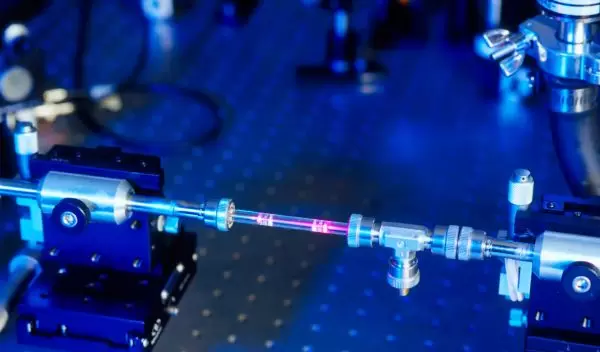
Breakthrough Brings Laser Light to New Regions of the Spectrum
Combining concepts from electromagnetic radiation research and fiber optics, researchers have created an extreme-ultraviolet, laser-like beam capable of producing tightly focused light in a region of the electromagnetic spectrum not previously accessible to scientists.
Between 10 and 100 times shorter than visible light waves, the extreme-ultraviolet (EUV) wavelengths will allow researchers to "see" tiny features and carve miniature patterns, with applications in such fields as microscopy, lithography and nanotechnology.
The achievement is based on a new structure called a "waveguide," a hollow glass tube with internal humps that coax light waves into traveling along at the same speed and help the waves reinforce each other.
In 2002, as part of a continuing project supported by NSF, a research team led by Henry Kapteyn and Margaret Murnane of JILA at the University of Colorado created EUV beams by firing a femtosecond laser through the gas-filled waveguide. A femtosecond is one-quadrillionth -- 1/1,000,000,000,000,000 -- of a second, and a brief pulse of the laser can be measured in these tiny units.
The new beam has peak powers approaching a megawatt and produces nanometer-scale light waves, yet the entire apparatus fits on a tabletop, unlike some room-sized counterparts.
"The new, laser-like, EUV source is smaller than any other EUV laser design at these very short wavelengths," Kapteyn said. "The waveguide fiber fits in one hand and the laser fits on a desktop."
The intense laser light literally rips the gas atoms apart, resulting in charged ions and electrons. The laser beam then accelerates the electrons to very high energies and slams them back into the ions, releasing electromagnetic radiation (in this instance, photons at EUV wavelengths).
Some of the EUV waves can be out of phase with the laser, canceling each other and weakening the strength and coherence of the output beam. However, by creating ripples in the diameter of the waveguide, the Colorado team coaxed the light waves from the laser and EUV beams into traveling at the same speed.
"These waveguide structures are amazingly simple -- just a modulated, hollow glass tube," Murnane said. "It is as if the laser beam 'surfs' on the modulations and is slowed down -- just as the speed bumps on the road slow a car down very simply and very effectively."
Slowing down the laser allows it to travel at the same speed as the EUV light and increases the efficiency of the process. The result is a well-synchronized stream of photons firing out of the system -- electromagnetic radiation boosted up to a high-energy, extreme-ultraviolet, wavelength.
Moreover, the peak power of the beam is higher than any other light source at the wavelengths it achieves -- all the way from the ultraviolet (UV) to the EUV region of the spectrum around 6 nanometers.
The Colorado group hopes to extend the beam's range into what scientists call the "water-window" -- the region of the spectrum below 4 nanometers where the light is perfect for imaging biological structures. Producing a beam in this region would allow the researchers to build a small microscope for imaging living tissues on a desktop or for viewing objects at the nanoscale.
"In 10 years, laser light will span all the way to the x-ray region of the spectrum," Kapteyn speculated. "The light will be used for the most precise microscopes that we can imagine, allowing real-time movies of the complex dance that atoms weave in chemical reactions and in pharmaceuticals yet to be visualized."
The research, reported in the journal Nature, was principally supported by NSF, with additional funds from the Department of Energy. JILA is managed by both the National Institute of Standards and Technology and the University of Colorado.
--Josh Chamot


